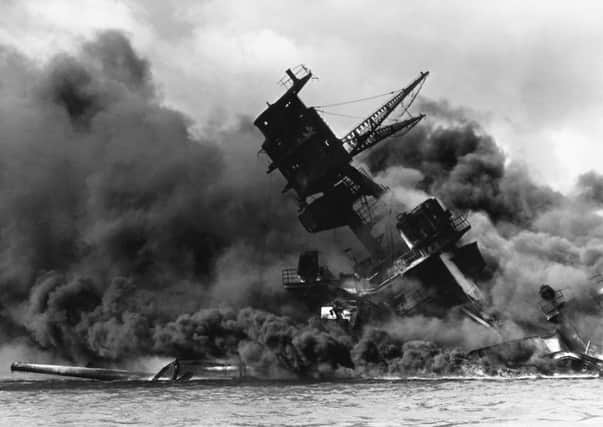Remembering Pearl Harbour: the attack that brought US into the war


Seventy-five years ago this month, on the morning of Sunday, December 7, 1941, Japanese bombers, fighters and torpedo planes attacked the American naval base at Pearl Harbor on Oahu Island, Hawaii.
This surprise attack brought the United States into the Second World War and changed the course of history.
Advertisement
Hide AdAdvertisement
Hide AdThe attack was the climax to a decade of deteriorating relations between the United States and an aggressively expansionist Japan.
Japan’s invasion of China in 1937, its subsequent alliance with Germany and Italy in 1940, and its occupation of French Indo-China in July 1941 prompted the United States to severe practically all commercial and financial relations with Japan.
Though Japan continued to negotiate with the United States up to the day of the Pearl Harbor attack, the government of Prime Minister Tojo Hideki had decided on war.
Admiral Yamamoto Isoroku, the commander-in-chief of Japan’s Combined Fleet, had planned the attack against the US Pacific Fleet with great care.
Advertisement
Hide AdAdvertisement
Hide AdYamamoto had opposed war with the United States because he feared Japan would lose a protracted struggle with such a powerful opponent. However, once the decision to go to war was made Yamamoto argued that Japan’s only chance for victory lay in a surprise attack that would cripple American naval forces in the Pacific, after which Japan could seize South-East Asia, the Indonesian Archipelago, and the South Pacific almost unhindered.
The naval general staff adopted Yamamoto’s plan for a carrier-based air strike on Pearl Harbor but Yamamoto accurately predicted that, if the war with the United States lasted more than a year, Japan would eventually be defeated.
Vice Admiral Nagumo Chuichi’s fleet, comprising six aircraft carriers, two battleships, three cruisers, and 11 destroyers, under strict radio silence, sailed to a point some 275 miles north of Hawaii. From there, some 360 planes set out for the American naval base at Pearl Harbor.
The first wave, consisting of 183 planes, arrived at approximately 7.50am on December 7, 1941. The Japanese goal was to destroy the ships on Battleship Row and the airplanes on the ground at the Naval Air Station and Wheeler Field and Hickam Field nearby.
Advertisement
Hide AdAdvertisement
Hide AdBecause it was a Sunday morning, most of the 780 anti-aircraft guns were not manned. Many military personnel were on shore for the weekend, while hundreds of others were still asleep on their ships.
Radar at Pearl Harbor picked up the incoming aircraft, but they were ignored: a US Army private who noticed the large flight of planes on his radar screen was told to disregard them because a flight of B-17s from the United States was expected at that time. A second wave of 168 Japanese aircraft descended an hour after the first, to inflict maximum damage, although most of the damage to the battleships was inflicted in the first 30 minutes of the assault.
By the time the attack was over several battleships had been destroyed or severely damaged: the Arizona was completely destroyed and the Oklahoma capsized and never saw service again. The Nevada, the California, and the West Virginia all sank in shallow water but were eventually repaired and sent back to sea.
Approximately 350 US Army, Navy and Marine Corps aircraft were destroyed on the ground. More than 2,403 Americans were killed, 68 of them were civilians and 2,008 were sailors. The Army lost 218 men and the Marines 109. Another 1,100 were wounded.
Advertisement
Hide AdAdvertisement
Hide AdIn contrast, the Japanese lost between 29 and 60 planes, five midget submarines, possibly one or two fleet submarines, and fewer than 100 men.
Despite Yamamoto’s careful planning, the Japanese failed to inflict a knock-out blow to the Americans.
Crucially, the US Pacific Fleet’s three aircraft carriers – Enterprise, Lexington and Saratoga – were not at Pearl Harbor. Two were at sea that morning; the third carrier was undergoing a refit in California.
This greatly reduced the impact of the attack because the coming war in the Pacific was to be a war conducted by carriers rather than by battleships.
Advertisement
Hide AdAdvertisement
Hide AdThe Japanese also had failed to destroy the oil storage tanks and naval dockyards at Pearl Harbor.
In early June 1942, less than six months after the attack of December 7, the United States Pacific Fleet was able to inflict a devastating blow on the Japanese navy and air force at the battle of Midway Island.
Until the Japanese attack on Pearl Harbor American public opinion was overwhelmingly hostile to entering the war. The attack on Pearl Harbor transformed the public mood and swept away hitherto strong support for American neutrality.
On December 8, congress declared war on Japan with only one dissentient vote.
Advertisement
Hide AdAdvertisement
Hide AdThe local commanders on Oahu, Admiral Husband Kimmel and Lieutenant General Walter Short, were relieved of their commands and held responsible for the fact that the base was totally unprepared at the time of the attack.
Some historians have accused President Roosevelt of having invited the attack (or at least done nothing to stop it) in order to bring the United States into the war against the Axis.
The expectation had been that the Japanese would attack the Philippines though an intercepted message revealed the real target was ignored.
On December 6 Dorothy Edgars of the US Navy’s Cryptographic Department translated a four-day-old intercepted secret Japanese diplomatic message. The message asked the Consul-General to send regular reports on all shipping movements, berthing positions and torpedo-netting at Pearl Harbor.
Advertisement
Hide AdAdvertisement
Hide AdTranslating three similar messages, she was alarmed by what she had read and took them to the head of the Translation Department.
He read them, made a few minor criticisms of her translations, and told her, ‘We’ll get back to this on Monday.’ By Monday, of course, it was too late.